The first chapter is a general introduction and describes the scope of the formation of copper-catalyzed C-N, C-O and C-S bonds with examples. It also describes the different mechanistic routes proposed for the reactions. The next two chapters describe the copper-catalyzed hydroxylation of aryl halides and the one-pot conversion of the resulting phenoxides to arylalkyl ethers. The fourth and fifth chapters are devoted to the copper-catalyzed synthesis of N-substituted benzo[d]isothiazol-3-ones and the subsequent titanium-catalyzed oxidation to N-substituted benzo[d]isothiazol-3-one-1-oxide .
In this chapter, we describe a sequential one-pot protocol for the conversion of 2-iodobenzamides to the corresponding N-substituted benzo[d]isothiazol-3(2H)-one-1-oxides (Scheme 4).
- Copper-Catalyzed C-N Bond Formation
- Copper-Catalyzed C-O Bond Formation
- Copper-Catalyzed C-S Bond Formation
- Mechanistic Studies
- References
Taillefer and co-workers demonstrated the use of Cu2O in combination with ligand L4 for the amidation of aryl halides. Liu and co-workers demonstrated the use of CuI/N-methylglycine system for N-arylation of amides. For example, Pan and co-workers demonstrated an efficient intramolecular C-S cross-coupling reaction of substituted 1-arylacyl-3-(2-bromophenyl)thiourea via CuI/N-(4,5-dihydroxazol-2-yl)benzamide (Scheme 32) ).
Bao and co-workers have established a synthetic protocol for the synthesis of 2-iminobenzo-1,3- oxathiol moieties using CuI/1,10-phenanthroline as a catalyst (Scheme 36).5l.
Copper-Catalyzed Selective Hydroxylation of Aryl Halides
Palladium Catalysts
The first use of C-O cross-coupling for hydroxylation of aryl halides was first achieved when Buchwald and co-workers demonstrated the hydroxylation of aryl bromides and aryl iodides by Pd2(dba)3 and a bulky monodentate phosphine ligand L1 or L2 in the presence of KOH in DMSO (Scheme 1).5a. Under these conditions, aryl bromides and aryl chlorides could be converted into their corresponding phenols in good to excellent yields.5b. Kwong and co-workers also demonstrated the conversion of aryl bromides and aryl chlorides to the corresponding phenols by Pd complex generated in situ from Pd2(dba)3 and tBu3P as a catalyst in the presence of potassium phosphate in toluene at 110 °C ( Scheme 3).5c.
The reaction is compatible with aryl bromides and aryl chlorides bearing electron-withdrawing groups or bulky groups on the aryl ring.5e.
Copper Catalysts
Subsequently, Beller and co-workers studied the hydroxylation of aryl halides using Pd2(dba)3 and imidazole-based ligand L3 in the presence of CsOH under heating (Scheme 4). U and co-workers thus demonstrated the conversion of aryl bromides and aryl iodides using CuI-1,10-phenanthroline as a catalyst in a 1:1 mixture of DMSO/H2O as solvent at 100 °C under inert atmosphere (Scheme 8) .6b. The hydroxylation of aryl bromides and aryl iodides was also achieved using Cu2O and pyridine-2-aldoxime in the presence of CsOH as hydroxide source in water (Scheme 11).
Similarly, Zhou and co-workers performed the hydroxylation of aryl bromides and aryl iodides using CuI and lithium picolinate as catalysts in the presence of NaOH as a hydroxide source and tetrabutylammonium fluoride as a phase transfer catalyst (Scheme 12).6e.
Present Study
Either lowering the catalyst amount (5 mol %) or copper to ligand ratio to 1:1 resulted in the reaction in <63% conversion. The reaction conditions were further investigated for the hydroxylation of less reactive aryl bromide and aryl chloride (Table 2). The scope of the procedure was then investigated for the reactions of other aryl iodides (Table 3).
In summary, the selective hydroxylation of aryl halides with nBu4NOH has been described in a shorter time by the combined use of CuI and 8-hydroxyquinaldine at moderate temp.
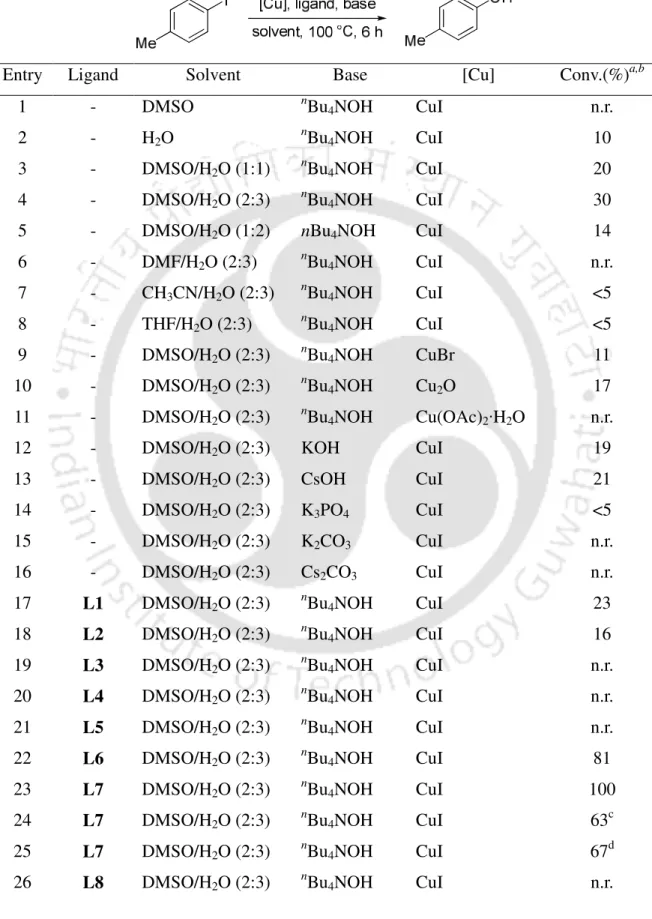
Experimental Conditions
The process is efficient, general and simple to synthesize substituted phenols and avoids the use of inert conditions.
One-Pot Conversion of Aryl halides to Alkyl Aryl Ethers
Introduction
Williamson Ether Synthesis
Mitsunobu Reaction
Transition Metal-Catalyzed C-O Cross-Coupling Reaction
C-H Functionalization
Electrocyclization
Aromatic Nucleophilic Substitution (S N Ar)
Alkylation of Phenols using Trimethoxyphosphine
Oxidation-Reduction Condensation
Present Study
The phenoxide was treated in situ with alkyl/allyl halide (2 mmol) and stirring was continued at 100 °C for 4–21 h. b Isolated yield. methylphenyl)-2-(prop-2-ynyloxy)benzamide and 84% and 90% yields, respectively (entries 7 and 8). Similarly, aryl iodides having 2-chloro, 3-methyl, 2,6-dimethyl, and 3,4-dimethyl substituents can be converted to phenoxides which in situ readily proceed with reaction with 1-bromooctane to give the ethers corresponding to 85-89%. yield (entries 6,9,19 and 20). Regarding aryl bromides, the phenoxide generated from bromobenzene was reacted with 1-bromobutane to give butoxybenzene in 87% yield (entry 1).
Similarly, aryl bromides with 2-methyl-, 4-chloro-, 4-methyl, 4-methyl and 4-nitro substituents were reacted with 3-bromoprop-1-ene, (chloromethyl)benzene or 1-bromooctane to give the respective ethers in 70-90% yield (entries 4,5,10-18). Also, 6-methoxy-2-bromonaphthalene could be converted to the respective phenoxide, which then on reaction with 3-bromoprop-1-ene provided 2-methoxy-6-(prop-2-ynyloxy)naphthalene in 76% yield (entry 21). In summary, we have devised the synthesis of alkyl aryl ethers from aryl bromides and aryl iodides.
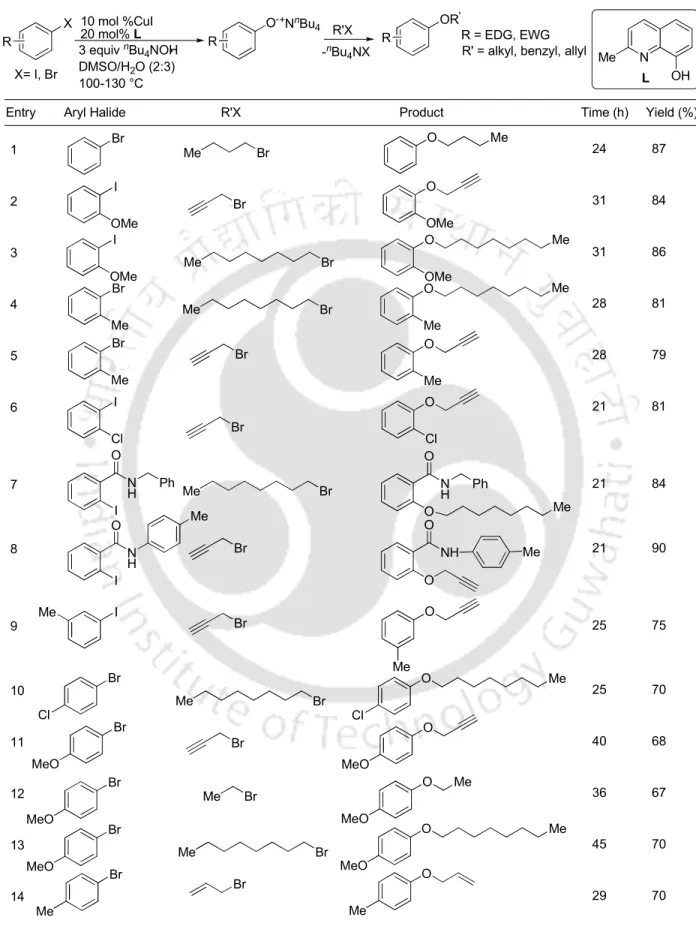
Experimental Conditions
Copper-Catalyzed Synthesis of N-Substituted Benzo[d]isothiazol-
Introduction
Classical Synthesis of N-Substituted Benzo[d]isothiazol-3(2H)-ones
Methods for Synthesis of N-Substituted Benzo[d]isothiazol-3(2H)-ones
Grivas demonstrated a modified method for the synthesis of N-substituted benzisothiazol-3-ones from 2-thiobenzoic acid, which are converted to the corresponding methyl-2-thiobenzoate. Uchida and co-workers investigated the conversion of N-alkyl and N-aryl-(2-methylsulfinyl)-benzamides to the corresponding benzo[d]isothiazol-3-ones by refluxing with thionyl chloride in dichloromethane (Scheme 4).4d. Similarly, N-alkyl or N-aryl-N-[(2-methylthio)benzoyl]-hydroxylamines could be converted to the corresponding benzo[d]isothiazol-3-ones by refluxing them with thionyl chloride in either dichloromethane or carbon tetrachloride ( Scheme 5).4d.
Abe and co-workers observed the cyclization of N-ethyl-2-iodobenzamide to the corresponding benzo[d]isothiazol-3-one by treatment with a stoichiometric amount of potassium [di(thiocyanato)copper(II)] in hot dimethyl formamide (Scheme 6).4f . Gates and co-workers described the general synthesis of N-substituted benzo[d]isothiazol-3-ones from 1,2-dithiolan-1-oxides by treatment with an alkyl amine or a substituted aniline in dichloromethane at 24 °C. 2 h (Scheme 7). 4g. Shimizu and co-workers synthesized benzo[d]isothiazol-3-ones from the corresponding 2,2'-dithiobenzamides by refluxing with an excess of O-methylhydroxyamine in propionitrile (Scheme 8).4k.
Recently, Sanmartin and co-workers synthesized N-aryl benzo[d]isothiazol-3-ones from the corresponding N-substituted 2-mercaptobenzamides by treating them with [phenyliodine(III)-bis(trifluoroacetate)] (PIFA) as an oxidant in of dichloromethane at 0 °C (Scheme 9).4l. Xi and co-workers reported the synthesis of N-alkyl benzo[d]isothiazol-3-ones from the corresponding N-alkyl-2-bromobenzamides using a combination of CuI and 1,10-phenanthroline in water at 160 °C (Scheme 10).4m. In addition to the synthesis of N-substituted benzo[d]isothiazol-3-ones, there are a few reports in the literature on the synthesis of unsubstituted benzo[d]isothiazol-3-ones.
Kajiwara and colleagues developed a protocol for the synthesis of benzo[d]isothiazol-3(2H)-one from 2-mercaptobenzoic acid by treatment with diphenylphosphoryl azide (DPPA) and subsequent stirring at room temperature (Scheme 11). Nam and colleagues were able to synthesize benzo[d]isothiazol-3(2H)-one from 2,2'-dithiobenzoate by treatment with an excess of acetamide and sodium methoxide in toluene in 90% yield (Scheme 12).4j .
Present Study
The scope of the procedure was investigated for the synthesis of a series of N-alkylbenzo[d]isothiazol-3(2H)-ones (Table 2). 2-Iodobenzamides with N -butyl, N -cyclohexyl, N -isopropyl, N -(1-phenylethyl) and N -(3,4-dimethoxyphenethyl) substituents proceeded the reactions to give the corresponding N -alkylbenzo[ d]isothiazol-3 (2H)-ones in 83-93% yield (entries 1-5). Furthermore, N -benzyl-2-iodobenzamides with 5-methoxy and 5-octyloxy substituents reacted to give the target products in 67% and 72% yields, respectively (entries 8 and 9).
In contrast, the substrates with N-(3-nitrophenyl) and N-(4-nitrophenyl) substituents were decomposed and the target compounds were not obtained (entries 4 and 8). To reveal the reactivity of the other aryl halides, the substrates with 2-bromo substituent (Table 4) and 2-chloro substituent (Table 5) were used under the reaction conditions. Thus, N-butyl-2-bromobenzamide underwent reaction with 60% yield, while N-benzyl-2-bromo-5-nitrobenzamide and N-benzyl-2-bromo-5-bromobenzamide continued reactions with 78% and 90% yield, respectively (Table 4, entries 2 and 3).
Similarly, N-aryl-2-bromobenzamides reacted to give the corresponding benzo[d]isothiazol-3(2H)-ones in moderate yields. For example, 2-chlorobenzamides with N-alkyl groups, N-benzyl-2-chloro-5-nitrobenzamide and N-benzyl-2-chloro-5-bromobenzamide gave the target molecules in 35% and 21% yield, respectively ( Table 5, entry 1 and 2), whereas N-(4-methoxyphenyl)-2-chloro-5-nitrobenzamide and N-(4-methylphenyl)-2-chloro-5-nitrobenzamide continued the reactions at 135°C with 45°C. %. Thus, disproportionation of the sulfur with a trace of moisture can give sulfide anion that could react with CuCl and sulfur to form MCuSn+1 (M = K or Cs).
Reductive elimination of b can give c which can transform into the target molecule d in the presence of base via nucleophilic substitution (Scheme 11).4f. In summary, copper-catalyzed synthesis of N-substituted benzoisothiazol-3-ones was developed from N-substituted 2-halobenzamides and sulfur powder via C-S cross-coupling reaction followed by N-S bond formation.
![Table 2. Copper-Catalyzed Synthesis of 2- Alkylbenzo[d]isothiazol-3(2H)-ones.](https://thumb-ap.123doks.com/thumbv2/azpdfnet/10344675.0/90.918.111.813.288.939/table-copper-catalyzed-synthesis-of-alkylbenzo-isothiazol-ones.webp)
Experimental Conditions
Benzylbenzo[d]isothiazol-3(2H)-one 4c (Table 1, Entry 1)
Butylbenzo[d]isothiazol-3(2H)-one 9b (Table 2, Entry 1)
Cyclohexylbenzo[d]isothiazol-3(2H)-one 9a (Table 2, Entry 2)
Isopropylbenzo[d]isothiazol-3(2H)-one 9d (Table 2, Entry 3)
Phenylbenzo[d]isothiazol-3(2H)-one 9d (Table 3, Entry 1)
Crystal Structure of N-(4-methoxyphenyl)benzo[d]isothiazol-3(2H)-one
One-Pot Conversion of 2-Halobenzamides to Benzo[d]isothiazol-
- Introduction
- Classical Synthesis of N-Substituted Benzo[d]isothiazol-3(2H)-one-1-oxides
- Titanium-Catalyzed Oxidation of Sulfides
- Present Study
- Experimental Conditions
- References
Titanium-catalyzed oxidation of sulfides to sulfoxides is a well-known and highly utilized reaction.5,6 In the presence of hydrogen peroxide as oxidant, the reaction becomes even more attractive due to the fact that hydrogen peroxide only generates water as a by-product.6, 7 There however, is a problem of overoxidation of the sulfides to the corresponding sulfones. Titanium-containing zeolites have been widely used for oxidation of alkylaryl sulfides to their corresponding sulfoxides. Similarly, Reddy and co-workers used titanium silicate TS-2 as a catalyst for the oxidation of alkylalkyl sulfides to their corresponding sulfoxides in the presence of dilute (26%) hydrogen peroxide as oxidant (Scheme 8).14.
Titanium trichloride (TiCl3) was successfully used as a catalyst for the hydrogen peroxide oxidation of sulfides by Oae and co-workers.15 The oxidation reactions were carried out in methanol at room temperature (Scheme 9). Shiri and co-workers used Preyssler-type heteropolyacid-modified nanosized TiO2 for the oxidation of alkylaryl sulfides to give the corresponding alkylaryl sulfoxides. Ti(OiPr)4 is widely used as a catalyst for oxidation of sulphides.17 Mayoral and co-workers thus demonstrated the use of Ti(OPri)4 as a catalyst for the oxidation of sulphides to sulphoxides.
Yang and co-workers used Ti(OPri)4 together with Schiff base L1 for the oxidation of alkylaryl sulfides to sulfoxides in the presence of H2O2 as an oxidant. Green and co-workers reported a new efficient protocol for the oxidation of various alkylaryl sulfides by aqueous hydrogen peroxide with a titanium-ligand complex supported on Wang resin (L2). Ti(iPrO)4 was used in the selective oxidation of sulfides to sulfoxides.17 The first practical and efficient oxidation method for the metal-catalyzed asymmetric oxidation of sulfides was reported independently by Kagan and Modena in 1984 (Scheme 16-17).17d - e.
Kagan and co-workers described a highly enantioselective oxidation of sulfides to sulfoxides mediated by chiral titanium complex using cumyl hydroperoxide as terminal oxidant. The oxidation of alkylaryl sulfides to the corresponding alkylaryl sulfoxides and alkylaryl sulfones has been extensively studied because of the importance of the products in the field of medicinal chemistry.5 In this chapter we describe a tandem one-pot synthesis of N-substituted .
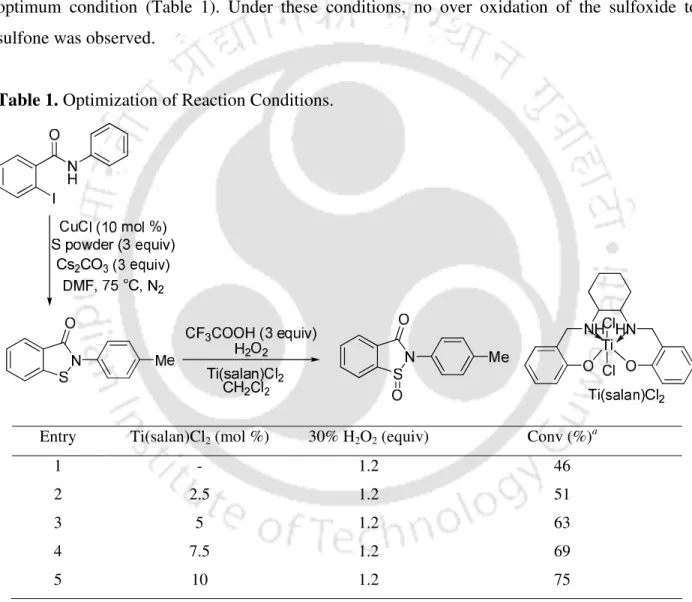
Conclusions
List of Publications
Conferences
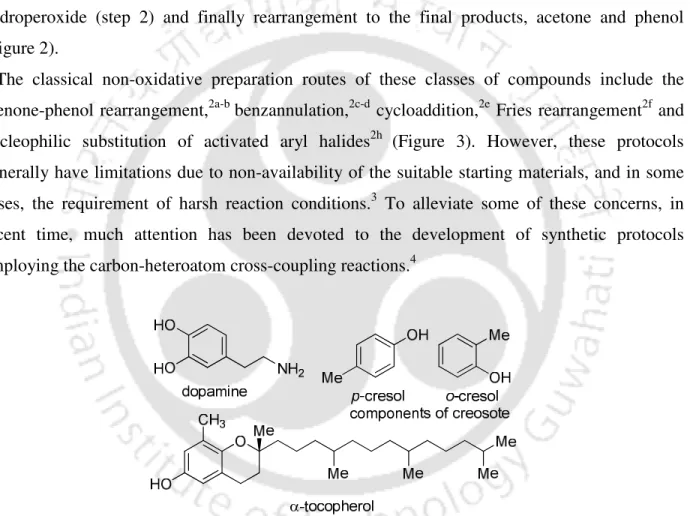
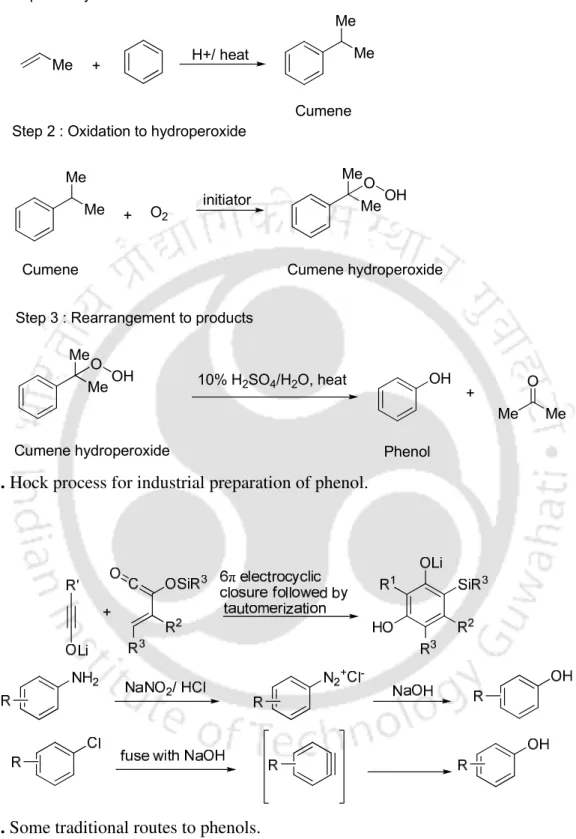
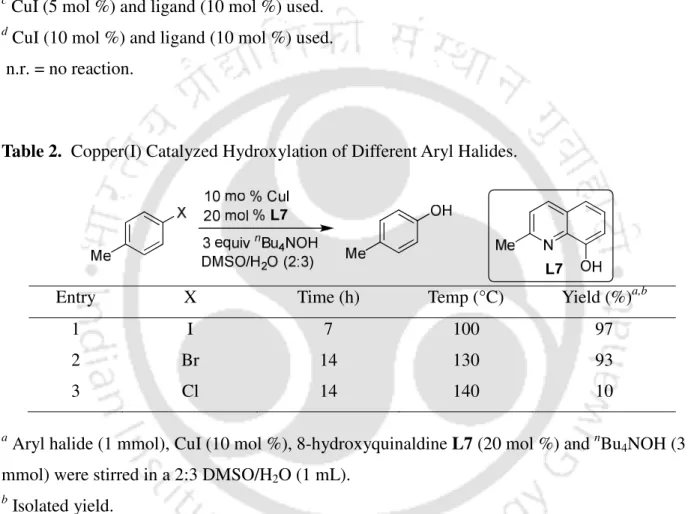
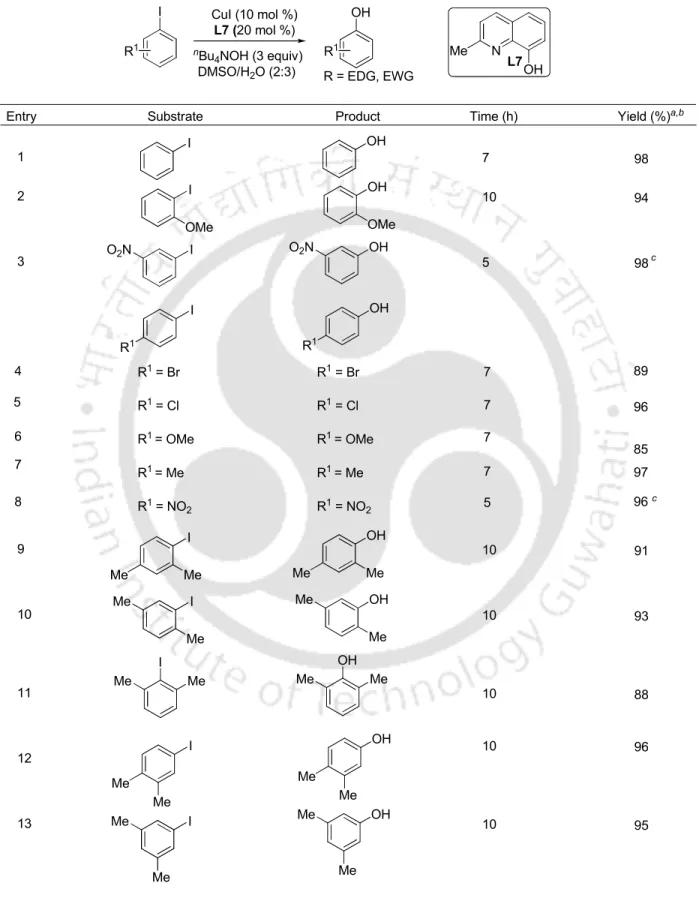
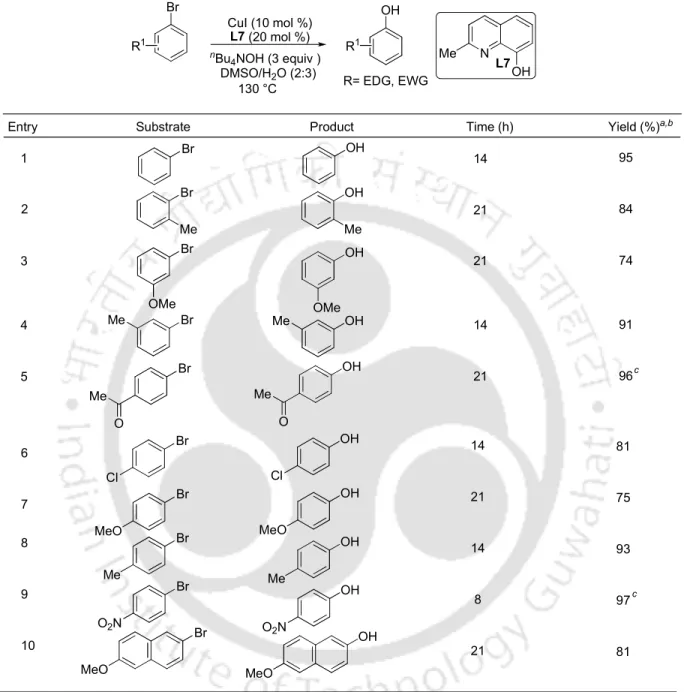
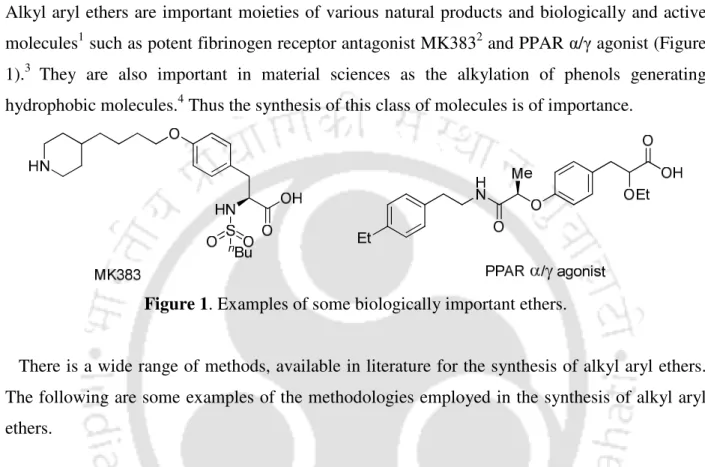
![Figure 1. Examples of biologically and industrially important benzo[d]isothiazol-3(2H)-ones](https://thumb-ap.123doks.com/thumbv2/azpdfnet/10344675.0/84.918.126.811.281.799/figure-examples-biologically-industrially-important-benzo-isothiazol-ones.webp)
